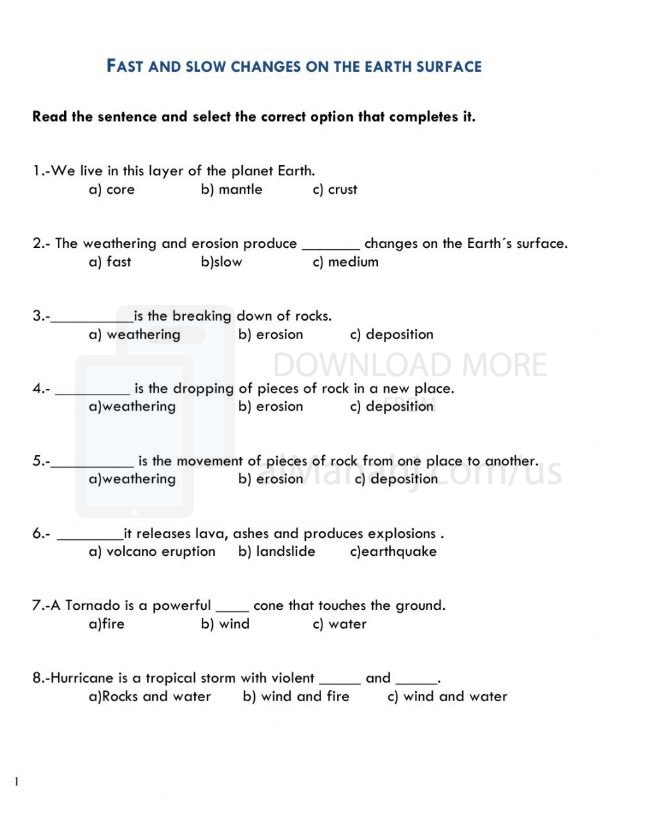| You are here: Almanahj Website ⇒ American curriculum ⇒ 8th Grade ⇒ Geology ⇒ Term 1 | ||
|---|---|---|
Worksheet about Changes on Earth surface | ||
|---|---|---|
| Subject: Geology | ||
| 8th Grade | ||
| Term 1 | ||
| Year: 2023/2024 | ||
| Size: 262.9KB | ||
| Number of clicks: 138 | ||
| Publish date:November 26, 2023 | ||
| Added by: Eman | ||
| Last download date: 2024-09-13 17:52:21 | By: theodor lzapata14 | |
| File info: The Earth's surface undergoes various changes over time due to natural processes and human activities. Here are some significant changes that occur on the Earth's surface: 1. Erosion: Erosion is the process by which soil, rocks, and sediments are gradually worn away and transported by natural forces such as wind, water, and ice. Erosion can reshape landscapes, create valleys, and contribute to the formation of features like canyons and river deltas. 2. Weathering: Weathering refers to the breakdown of rocks and minerals on the Earth's surface due to exposure to weather conditions such as temperature changes, water, and chemical reactions. It can lead to the formation of new soil, the disintegration of rocks, and the alteration of landforms. 3. Deposition: Deposition occurs when eroded materials, such as sediments and soil particles, settle and accumulate in new locations. This process contributes to the formation of sedimentary layers, river deltas, beaches, and alluvial plains. 4. Volcanic Activity: Volcanic eruptions can bring significant changes to the Earth's surface. Lava flows can create new land, while volcanic ash and gases can alter the composition of soil and affect local climates. Volcanic eruptions may also form volcanic mountains and calderas. 5. Tectonic Plate Movements: The movement of tectonic plates, as described by plate tectonics, causes various changes on the Earth's surface. Plate boundaries can result in the formation of mountain ranges, earthquakes, volcanic activity, and the opening or closing of ocean basins. 6. Human Activities: Human activities have a considerable impact on the Earth's surface. Deforestation, urbanization, mining, and construction can lead to habitat loss, soil degradation, and changes in land use patterns. Additionally, activities such as dam construction and land reclamation can alter natural waterways and coastlines. 7. Climate Change: Climate change, largely influenced by human-induced factors such as greenhouse gas emissions, is causing significant changes on the Earth's surface. Rising global temperatures are leading to the melting of glaciers and polar ice, sea-level rise, shifts in precipitation patterns, and changes in ecosystems. These are just a few examples of the changes that occur on the Earth's surface. It's important to note that the Earth's surface is a dynamic and ever-evolving system influenced by a range of geological, biological, and anthropogenic factors. | ||
| Downloading link Worksheet about Changes on Earth surface |
|---|
|
1701011449.pdf
The file is being prepared for download
|
| File images |
|---|
 |